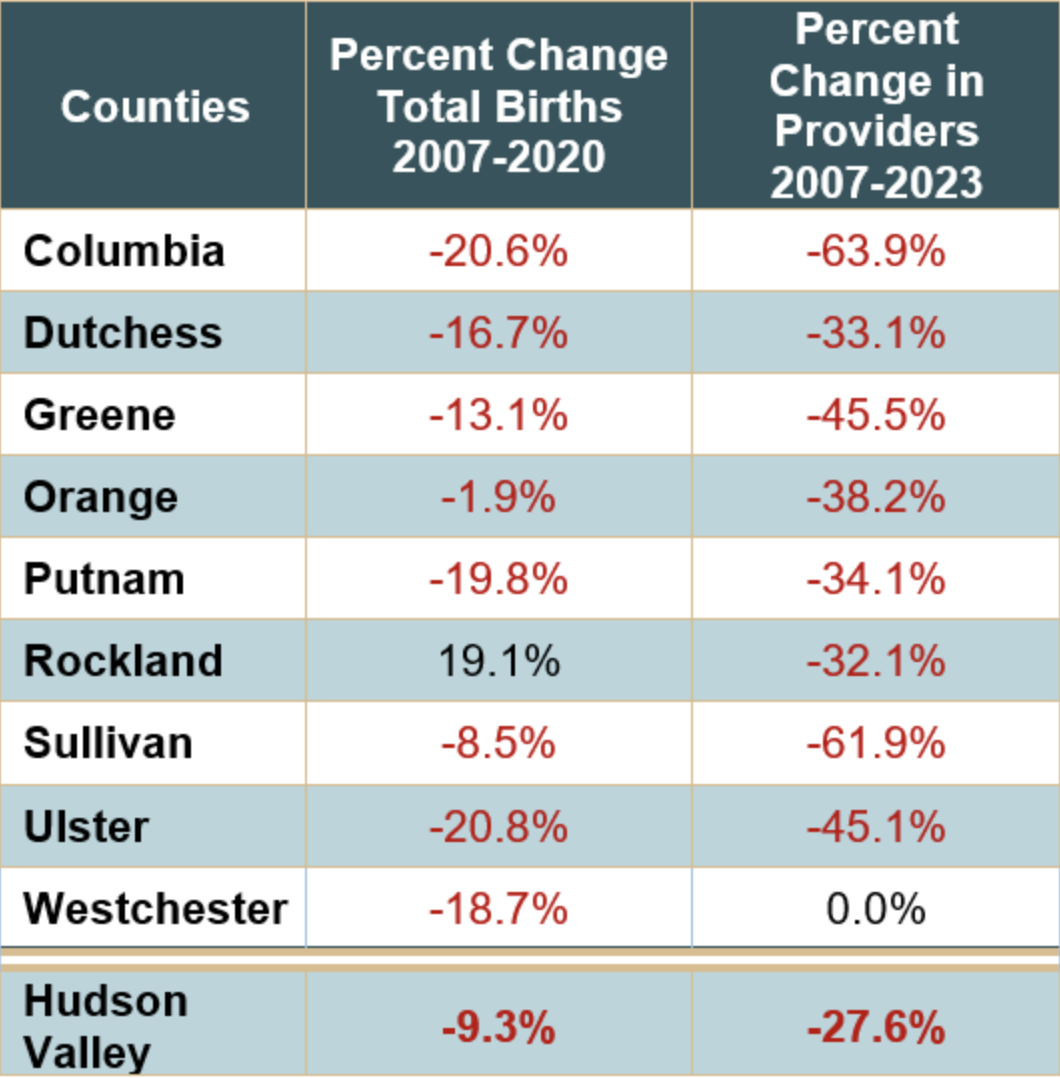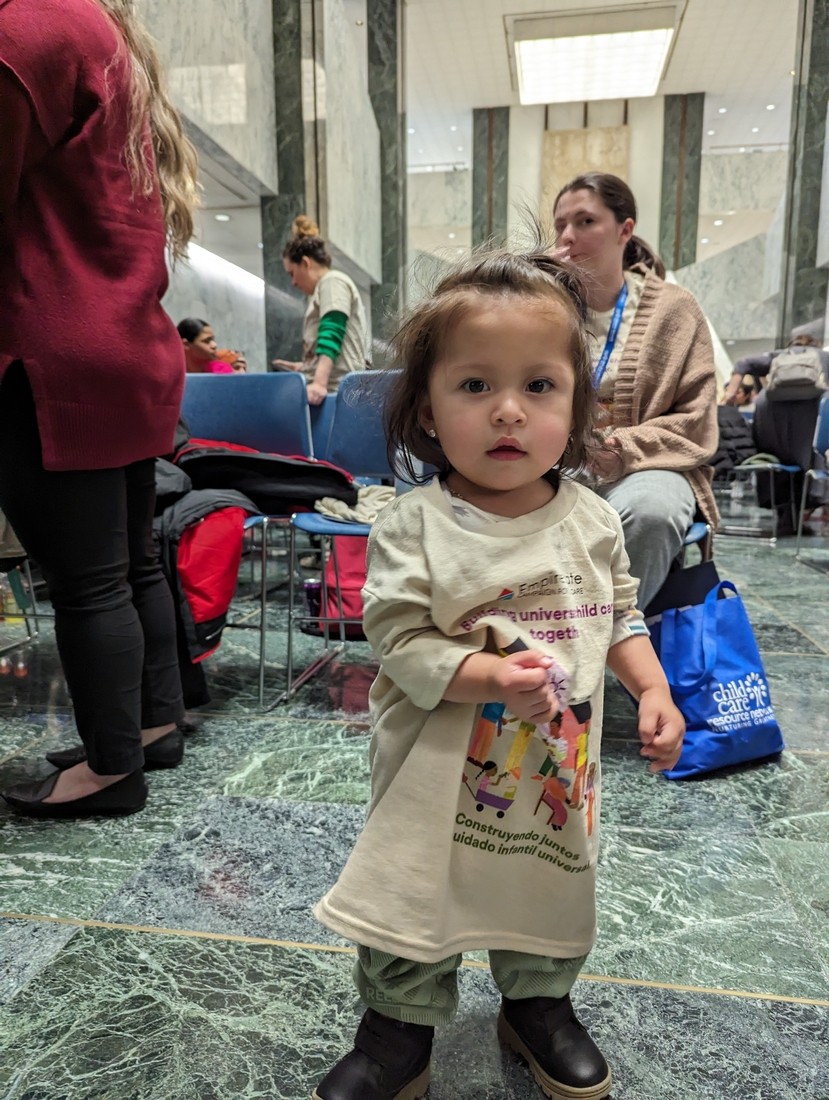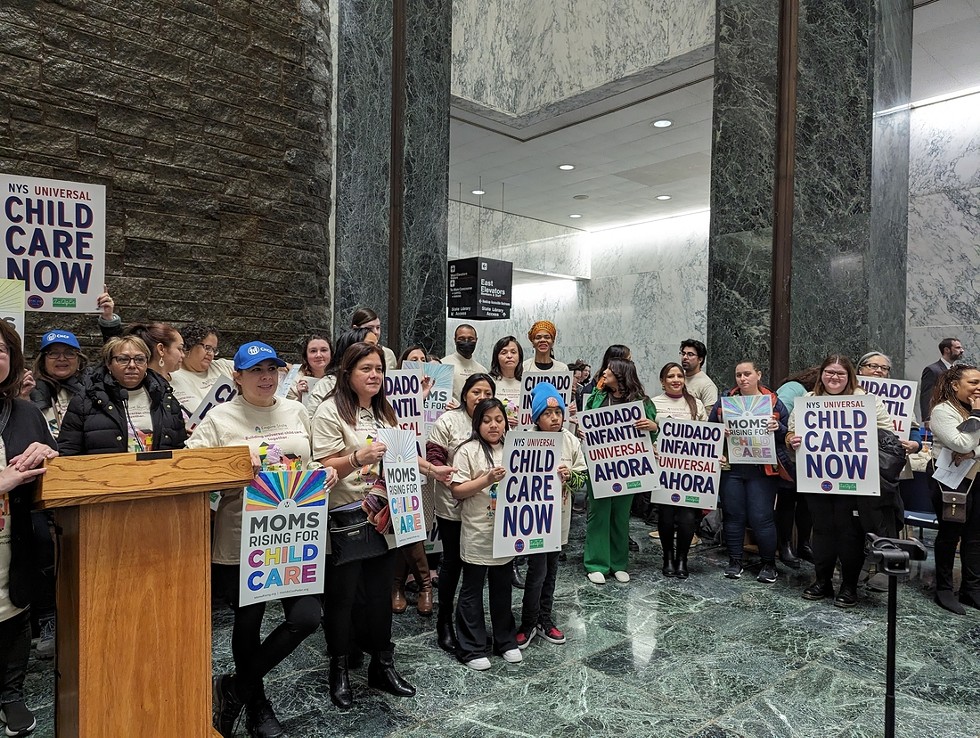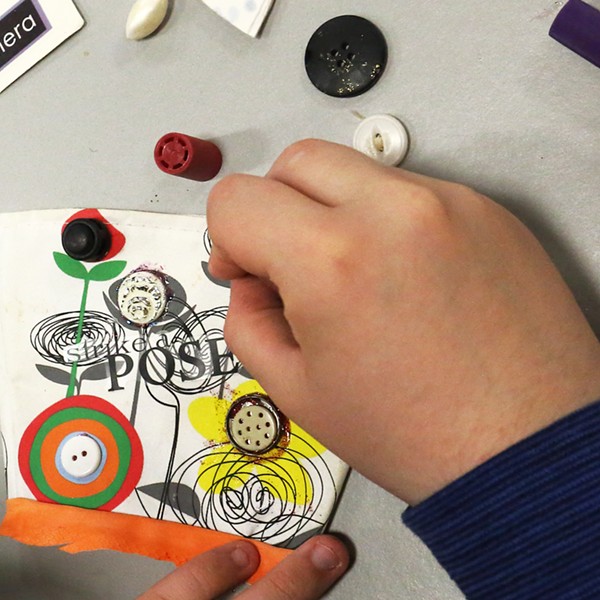As Kasia Donohue pulled into the last available spot in the State Capitol parking lot in Albany on February 6, she was feeling hopeful. She had the day off from work as a tenants’ rights attorney so she could participate in the 2024 Childcare Advocacy Day (an annual event to lobby for investments in childcare priorities during the New York State budget cycle). Then she checked her phone. A text from her son’s daycare said they were incredibly sorry but, due to lack of staffing, they couldn’t keep the toddler room open. “Please come pick up your child immediately.” The irony that Donohue couldn’t lobby for childcare due to lack of childcare was not lost on her.
“I was hoping to speak to legislators and tell them the specific challenges we’ve found with locating daycare,” Donohue says. She moved to Saugerties when her son was six months old. Aiming to start back at work, she found that she wouldn’t be able to until he reached 18 months old, due to limited spots in infant care. As an attorney who appears in court with her clients, remote or part-time work were not viable options, so Donohue was out of the workforce for a year.
Organized by Empire State Campaign for Childcare, a statewide grassroots organization born during the 2017 budget negotiations and led by state legislators and activists with the goal of achieving equitable access to universal childcare for all children and families in New York State, the 2024 Childcare Advocacy Day set as this year’s goal the creation of a permanent $1.2 billion state fund to provide employees in licensed programs compensation parity to similar public school positions.
“Sixty four percent of New Yorkers live in what's known as a childcare desert: For every available slot, there are between three and nine kids waiting. If we can get a larger childcare workforce to stay on board, then we can begin to meet the needs of families.” —Shoshana Hershkowitz, campaign manager for Empire State Campaign for Childcare
tweet this
Childcare workers are predominantly women and, in the Hudson Valley, wages range from $31,980 to $35,670, annually. The Bureau of Labor Statistics cites childcare as having one of the highest employee turnover rates of any industry in the nation—nearly 20 percent. Campaign Manager Shoshana Hershkowitz says daycare is losing employees to better paying jobs at big box stores. “Sixty four percent of New Yorkers live in what's known as a childcare desert: For every available slot, there are between three and nine kids waiting. If we can get a larger childcare workforce to stay on board, then we can begin to meet the needs of families.”
The industry is so stretched that if an employee calls in sick, a classroom might close at a moment’s notice, putting parents in a precarious position. That’s a staffing issue according to Hershkowitz. “What we're advocating for is a universal childcare system that translates childcare into the public good that it should be, rather than the private burden that most parents are experiencing,” she says.
What Killed Childcare
Childcare scarcity across the Hudson Valley is projected to only get worse. A new report from Hudson Valley Pattern for Progress, "Childcare in the Hudson Valley", is their first regional analysis of childcare trends. The topic first caught the attention of President and CEO Adam Bosch in 2022 when thematic discussions about availability, affordability, and labor participation led local leaders to conclude that the region has a childcare problem. But recently, in an annual survey done by Empire State Development and the Department of Labor, childcare climbed the list of support services employers want in the region but can’t provide. “Traditionally transportation has been number one, but childcare outpaced transportation by 10 percentage points this time around,” Bosch says. “That was an indication to us that increasingly childcare is a top-of-mind issue for employers across the Hudson Valley.”

Pattern collected data from years between 2007 and 2023, bracketing the Great Recession and the Covid-19 pandemic, to determine any measurable impacts on childcare in the region. What they found is that, outside of Westchester County (which has seen a zero percent change), there’s been a 27 percent decrease in childcare providers. Now if every childcare provider in the region filled to maximum capacity, there would only be enough spots for about 58 percent of children who haven’t yet started school. Some of the closures are due to declining births, the outward migration of young families from New York, and it tracks with statewide trends. “However, the proportional decrease in childcare businesses has far outpaced the decline in births and the overall population of children under the age of 10 in practically every county throughout the Hudson Valley,” the report states.
Nona Willis Aronowitz, a journalist, moved to Kingston from Tannersville when she had a baby, hoping to expand her daycare options. In rural parts of the region, one childcare provider might serve many communities, requiring long drives and making closures more impactful. But the report notes that childcare scarcity is not only a rural issue; eight of the region's 13 cities have also seen a significant drop in the number of childcare businesses. In Kingston, which lost over 58 percent of providers during the study period, Aronowitz found long wait lists and rates of $22 to $25 an hour for nannies. She went on daycare tours to prove her interest, and regularly called for updates on openings, but it still took months to find her daughter a spot. “When I had a child, I braced myself for how expensive childcare was going to be,” Aronowitz says, “but it didn't occur to me that, even if I had money to spend, there wouldn’t be many options. Clearly, the specifics are different: being able to afford it versus being able to find it. But even the privileged among us have gotten disillusioned by the state of childcare, and it's actually a point of solidarity.”
One reason for daycare closures is increased accessibility to Universal Pre-K (UPK), a state and federally funded free preschool program available by lottery at some public schools for a select number of four- (and sometimes three-) year-olds who live in the school district—not generally a bad thing. Evidence shows that UPK provides better outcomes for academic achievement, earning potential, and health, and decreases crime. Plus, it’s free for those who get into the lottery.
The problem is that UPK undermines the economic model of childcare. According to the Pattern report, “Infants are the most expensive children to care for because state regulations require licensed providers to have one staff member for every four infants. By the time children reach four, that ratio increases to one staff member for every eight children. That means childcare businesses make roughly twice the revenue from each four-year-old compared to each infant, making the older kids an especially important source of revenue for their businesses.” With UPK, childcare providers lose the market that helps them fund infant care. “We can say we want more childcare, we can set aside funding,” Bosch says, “but why would someone essentially buy into a business model that's broken?”
The High Cost of Childcare
Employers told Pattern about their growing concerns around two central themes: losing employees, especially women, who decide to leave the workforce rather than put the majority of their incomes toward daycare; and being unable to hire employees because of limited daycare options in the area. One recommendation in the study is for the state to run a pilot program, allowing employers to open safe in-house childcare, paired with additional monitoring and some leeway, to assess what the current regulations don’t address.
“When I had a child, I braced myself for how expensive childcare was going to be, but it didn't occur to me that, even if I had money to spend, there wouldn’t be many options." —Nona Willis Aronowitz
tweet this
President Container Group in Middletown studied the costs and requirements to build a multi-room daycare with outdoor playground for their employees’ infant to preschool-aged children and grandchildren. (Middletown lost 50 percent of its childcare providers since 2007.) The primary manufacturing arm of four companies, the factory produces corrugated sheets and convert them into boxes, containers, and displays.
In a pre-pandemic survey of their 365 employees, they found overwhelming interest in on-site, affordable daycare. “It’s hard to find childcare for an overnight or 12-hour shift,” says Plant Superintendent John Fong. “So to make it less of an inconvenience on families, we were looking to help.” It wasn’t the extensive background checks, or the cost of constructing a safe space for children that addressed the fire codes for a paper-product facility, or even the need to hire six caregivers for 15 to 20 children—all challenges they could meet; it was the astronomical cost of insurance that killed the idea.
The plant is committed to good male-to-female employee ratios, and to addressing prospective employees’ needs: working with recruiters to develop applicants, providing ESL classes, and quickly onboarding new hires so they can get the union’s health and retirement benefits. Their HR and Quality Control departments employ many women, but Fong believes that daycare scarcity prevents more from applying for factory floor work. “And that puts a strain on families having two incomes instead of one,” Fong says. “If we had more affordable childcare in the area, that would give us the hiring pool to bring more females into the industry.”

Daycare in the Hudson Valley averages $12,000 to $15,000 annually per child. But the state recently expanded eligibility for its Child Care Assistance Program (CCAP), raising the income limit to 85 percent of New York’s median income, which, for a family of four, is roughly $93,000 annually. Another report recommendation was for increased awareness of CCAP; Pattern found that less than 50 percent of the money was used by eligible Hudson Valley families in 2022 due to problems with marketing and implementation. Donohue, for example, didn’t know about the subsidy, and suggested that it be included with daycare prospectus materials during enrollment, an optimal time for families to learn about it. But as Hershkowitz points out, “Now we have many more families who are eligible, but what we don't have is the workforce capacity to meet those needs.”
“The most relevant outcome of the study that people need to pay attention to is that our childcare system is suffocating under the weight of the region having fewer children, the cost being high and the pay being low, and a substantial portion of children being taken out of the system to the point where it's having a hard time surviving,” Bosch says. “It's hard to imagine that the trend doesn't continue, and childcare whittles until it's almost a luxury service. It gets down to the viability of the region as a place where working people can live, raise a family, and be reasonably comfortable doing those things.”














